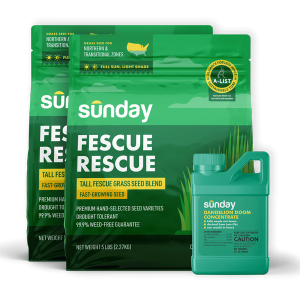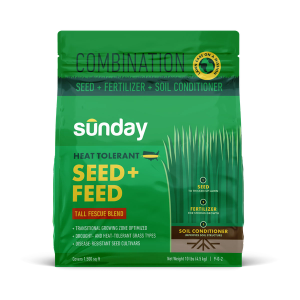Why does flooding occur?
Flooding within your lawn can occur for a multitude of reasons. Some likely culprits include:
- Consistent or heavy rains
- Inclement weather, including increasingly severe storms from a changing climate
- Poor drainage or soil compaction in your lawn
- Low points, also known as "flood zones," which can include deep slopes in lawns
- The location of your property, specifically lawns near large bodies of water or coastlines
Flooding and turf survival
When your lawn floods, the survival and resiliency of your grass will depend on:
- What kind of grass you have, and how long it's underwater. Your lawn's survival will depend on a combo of the grass type and how long it's underwater. Below are the warm- and cool-season Sunday grass types that will have the greatest resiliency to flooding, along with some general estimates on how long they can withstand flooded conditions.
- Bermudagrass can withstand flooding for up to 55 days
- Kentucky bluegrass and tall fescue can withstand up to 35 days
- Perennial ryegrass can withstand somewhere just under 35 days
- How deep the flood waters are. The deeper the water, the higher the chance it will damage your lawn.
- The temperature of the water. The warmer the water is, the greater the damage to your grass. Temperatures between 50 and 86 degrees Fahrenheit are bad news for your grass, and the situation worsens when those temperatures climb above 86 degrees Fahrenheit.
- How intense the sun is. More sun means a higher water temperature, which in turn is more likely to damage your lawn.
Sunday Tip:
Beware of scalding caused by flooding. Scalding happens during the brief period where the grass is submerged in water under very warm temperatures due to a combination of submersion, water temperature and light.
How to assess damage from flooding
When you're trying to figure out just how much damage there is, consider the following:
- Watch out for high temperatures. Conditions like heat or drought increase the likelihood that your grass will die, and temperatures over 80 degrees Fahrenheit can kill your grass in just a few days.
- Look for discoloration. Yellow or browning turf can happen for a few reasons. Your grass needs chlorophyll and nitrogen, and flooding can cause those important nutrients to leach out. Compromised roots that are unable to absorb nutrients can also cause discoloration.
- Keep an eye on how long water sticks around. Low oxygen is an immediate effect of flooding itself - submerged grass can't take in oxygen. In the case of long-term submersion, this may cause root hairs to die, which then causes the your grass to die.
- Evaluate the type of water damage. Depending on where you live, you might encounter these types of water damage:
- Inland: Flooding from rivers brings silt and fine particles that may settle out into your lawn. The additional particles (like silt or clay) can smother the grass, reduce photosynthesis, and impact the soil.
- Coasts: Flooding from oceans brings saltwater to your lawn, and salts can impact soil and plants. This is because salt can mess up your property's soil structure, and can even burn your plants, which causes a yellow discoloration.
Recover lawns from flooding with Sunday
- Keep off your lawn. Stay off your grass and soil until the water recedes.
- Check if the grass is still alive. After the water recedes, check to see if your grass is alive before you repair it.
- Do a bioassay test: Cut a sample from your turf, bring it inside, and see if it will grow. Allow 1-2 weeks for growth to occur.
- Smell the grass: This is a simple test. If it's dead, it will smell like sulfur (think burnt matches or rotten eggs) due to decomposing plant material and low oxygen levels in your soil.
- Do a crown test: Look at the base of your grass where new growth comes from. If it's dead, this part of the grass will be brown and mushy.
- Remove sediment. If a lot of sediment (especially silt or clay) accumulated on your lawn, try to shovel or carefully powerwash it off. Limit introduing new water wherever possible.
- Aerate your lawn. If it's not practical to remove the dead grass, aerate and incorporate (e.g. mix-in) into the existing soil.
- Plant more grass. The best thing you can do to address lawn damage is plant more grass. If your region or lawn is prone to flooding, remember to plant grass types that are most resistant to flood damage.
Cited Sources
Flooded Turf and Salt Overwash. University of Cornell.
Lawn care: spring floods and drought….really?. University of Minnesota
Repairing Lawns Following Flooding. University of Minnesota.




















